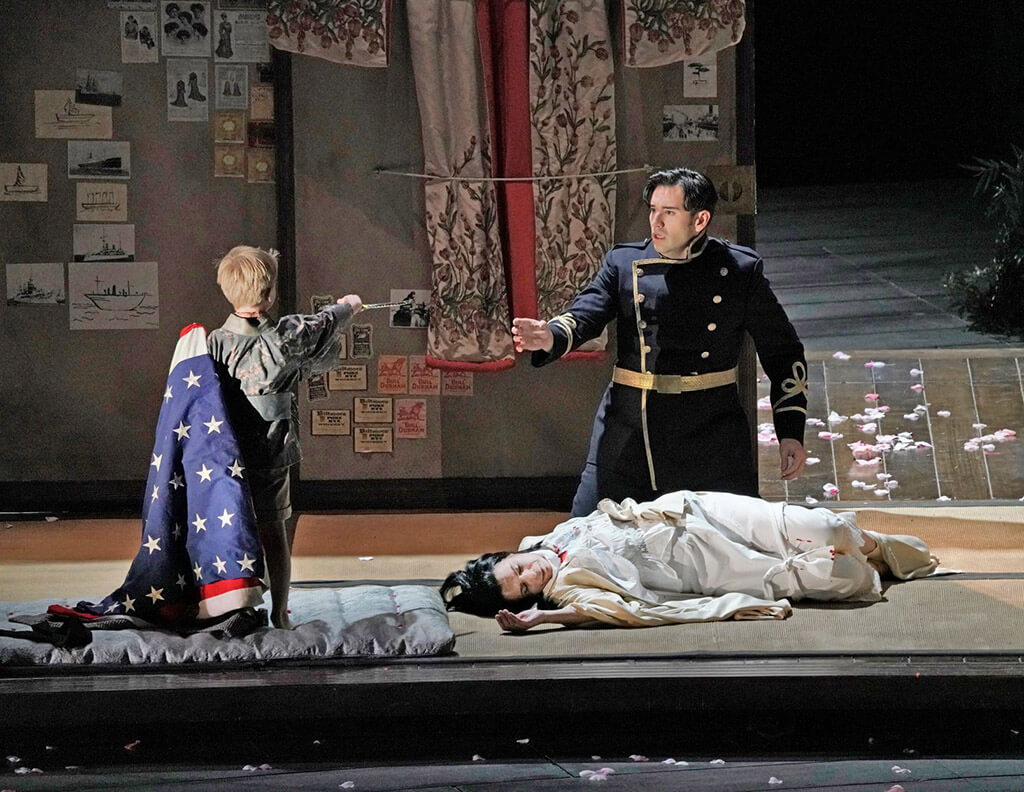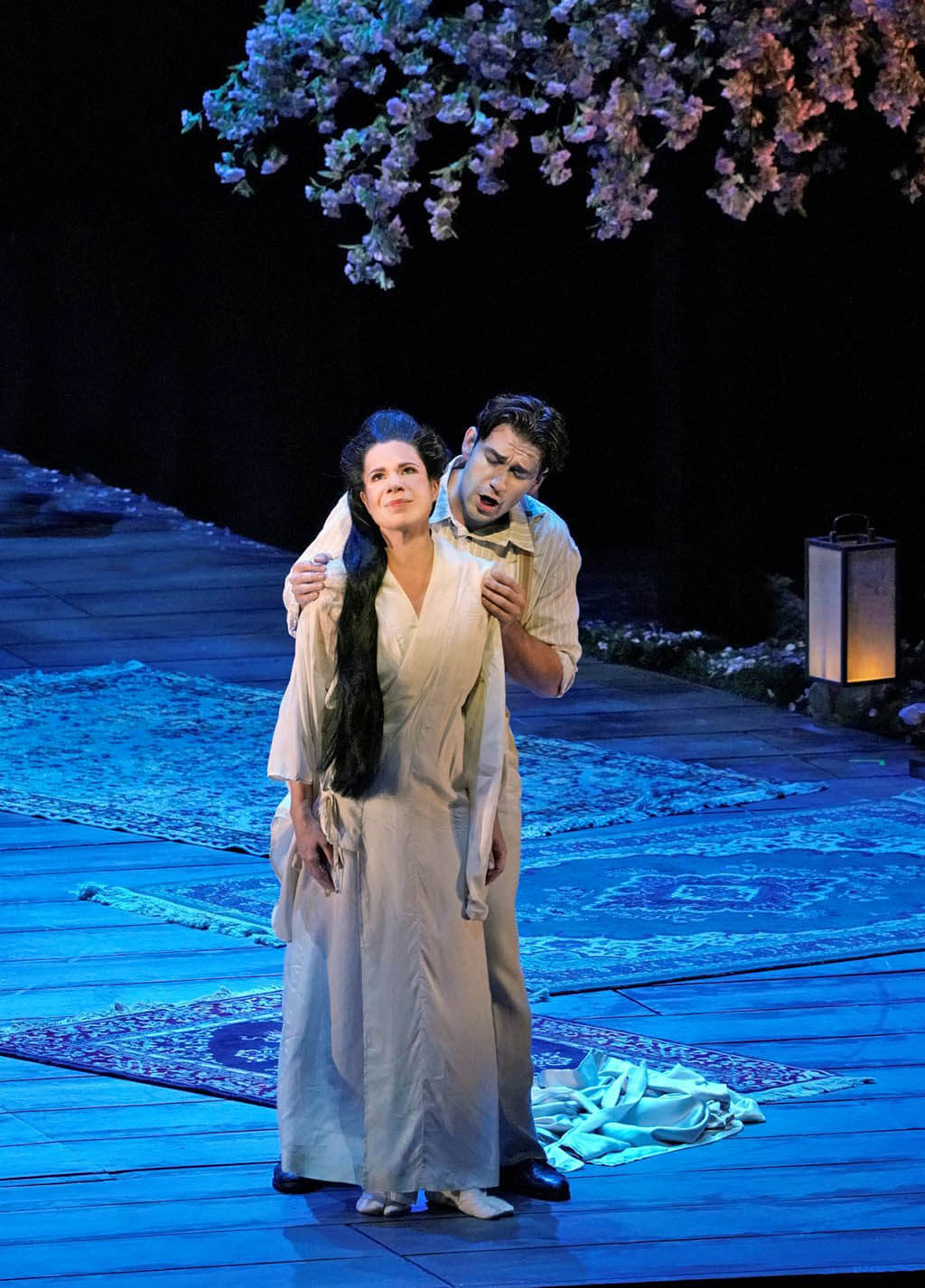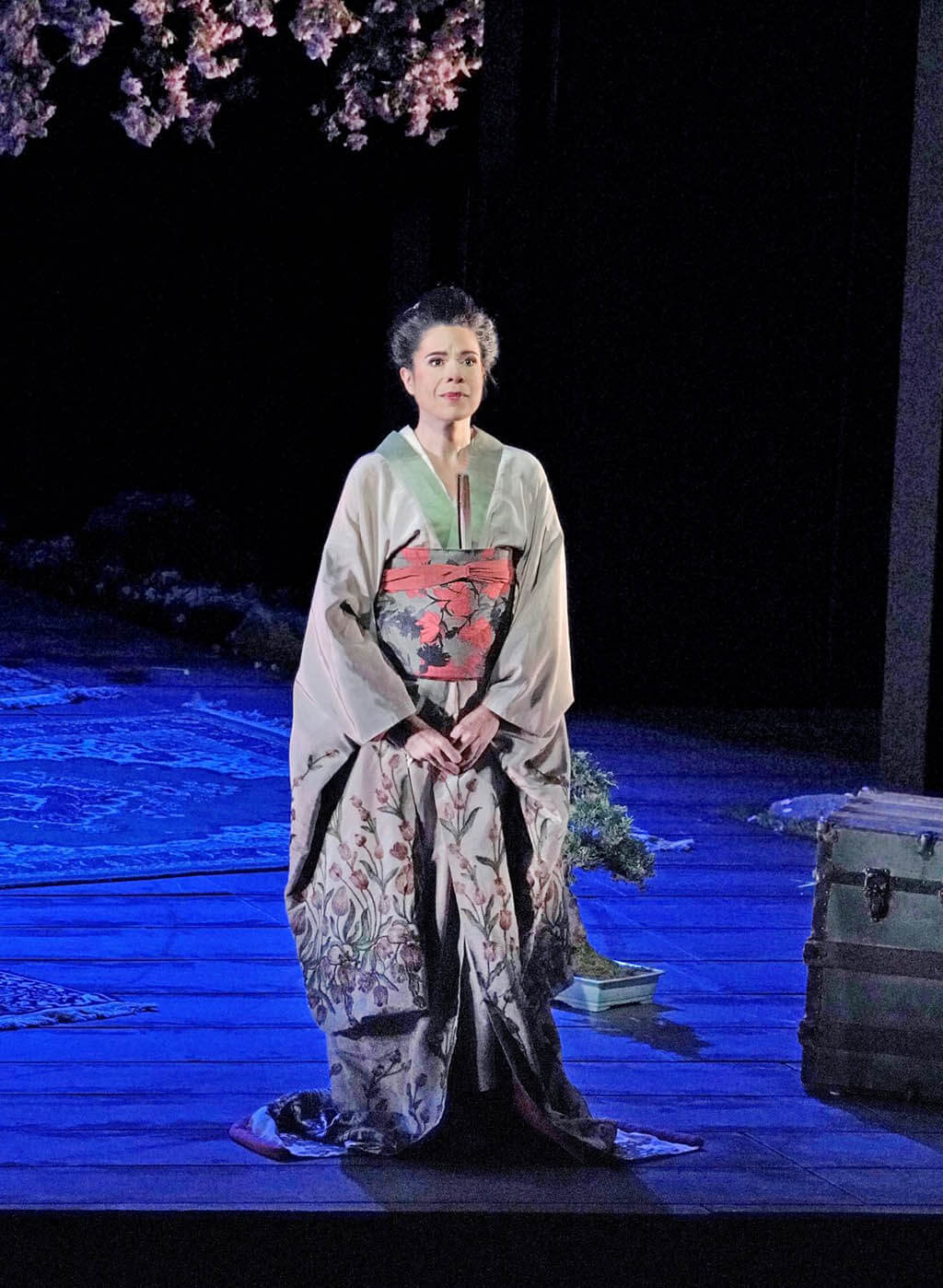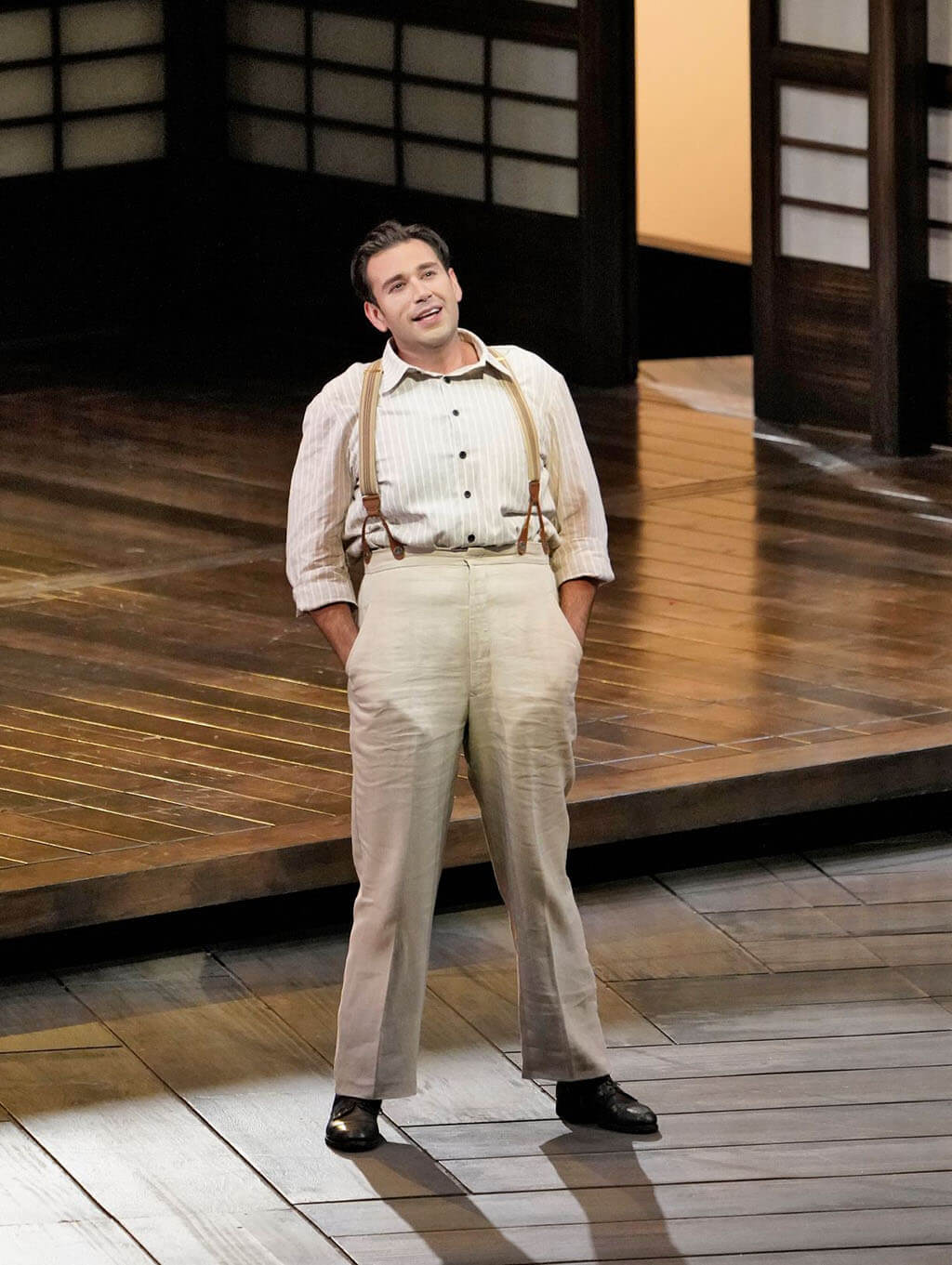
Madama Butterfly by Giacomo Puccini. Santa Fe Opera; Ana Maria Martinez (Butterfly); Joshua Guerrero (Pinkerton); Nicholas Pallesen (Sharpless); Megan Marino (Suzuki); John Fiore, conductor; Matthew Ozawa, director, July 30, 2018.
SANTA FE — According to opera performance statistics on the just concluded 2017-18 season, Puccini’s Madama Butterfly remains one of the most popular in the world, ranked 7th out of a total of 2,317 operatic works that received performances worldwide last season. It’s easy to see why, given its felicitous mix of sublime melodies, glorious music, exotic locale (particularly for a western audience), framing a heart-wrenching love story of intercultural conflict, it has withstood the test of time. And if you are lucky enough to get great voices, a fine orchestra, in an evocative production, it makes for a most satisfying evening at the opera.
Such was the case last evening at Santa Fe Opera, in the first of five productions I’m seeing on my annual trip to this magnificent theatre in the New Mexican desert. The Lee Blakeley production is a revival, premiered at Santa Fe some eight years ago. I was very impressed at the time, and it’s great to experience its power and sweep again. Sadly, the British stage director passed away a year ago from a massive heart attack, but his legacy lives on in this production. This revival is directed by young American Matthew Ozawa, in his Santa Fe Opera debut. Dramatically true to Blakeley’s vision, the few variants I noticed are musical ones – more about that later.
Last evening, I was once again struck by Blakeley’s rather unusual take on the heroine, Cio-Cio-San. In most directorial takes, she is an exotic flower, a soft, delicate, vulnerable Oriental beauty, ultimately a tragic figure, a victim, a creation of John Luther Long and David Belasco. That said, it must be noted that the character of Cio-Cio-San is a creation through the Eurocentric lens of the western male literary imagination, a vision of the ‘ethnographic other’ that’s not based on first-hand experience. Blakeley’s re-thinking perhaps represents an attempt to get away from the Western stereotypes of the Asian woman, while respecting the spirit of the original creation.

To be sure, Blakeley was not alone. Various attempts have been made in recent years to re-imagine this piece to resonate with 21st-century sensibilities. I had the “good fortune” of having seen a radical re-interpretation of Madama Butterfly some fifteen years ago, in a Komische Oper production by Calixto Beieto. I will skip some of the gory details except to say that instead of committing ritual suicide, this Cio-Cio-San stabs the child, slashes Suzuki, and when Pinkerton comes in at the end, she is waiting for him behind a Shoji screen with a big knife as the curtain comes down. Incredibly there were wild cheers by the youngish audience at the end, but the experience left me with nightmares afterwards.
Thankfully, Lee Blakeley’s vision, while somewhat unconventional, does not change the story, nor go against the spirit of the work. His Cio-Cio-San is strong and resolute, even if ultimately she does not escape her tragic end. A lot of the western conception of the Japanese is gone — there is no exaggerated Orientalist mannerisms such as the mincing walks that pass for graceful femininity. In Act Two, Butterfly is in western clothes, her home decorated by an enormous American flag. After her confrontation with Kate Pinkerton, Butterfly retreats to her home and starts throwing her western style furniture around. After she kills herself, Trouble wraps himself with the flag, picks up the knife and points it at the entering Pinkerton, an action that packs an emotional wallop for the audience. Cio-Cio-San refuses the money Sharpless tries to give her in Act Three, even after she has descended into poverty.

The production with set design by Jean-Marc Puissant benefits from the open vista at the back of the stage, revealing the gorgeous New Mexican sunset. With the 8 p.m. curtain, the progressive darkness in Act One makes for a magical moment. With total darkness for Acts Two and Three, the setting works less well. Cio-Cio-San’s house, now located next to power lines, signifies her descent into poverty. Act Three takes place as dawn breaks, with light and birds chirping. With the stage surrounded by darkness, it doesn’t work as well.
Musically this revival is distinguished by its use of the second, so-called Brescia version of the score. The first version was met with failure, resulting in extensive revisions by Puccini, who cut out some music while adding and polishing other parts of the score. Puccini also inserted Pinkerton’s Act Three aria in the Brescia version. But a lot of the material in Act One that ultimately was cut in the final version is still there in the Brescia version, such as the music of the wedding guests. I have not actually timed it, but my guess is an additional 10 minutes of music, mostly in Acts One and Three. Act Two is essentially the same. At the end of the day, I am glad I had the chance of hearing the Brescia version — as a curiosity. In no way is it equal to the final version. Puccini, a master of the theatre and a supreme melodist, knew what he was doing.

As performances go, last evening was very enjoyable, thanks to the beautiful vocalism by the leads. When I saw this in 2010, Kelly Kaduce was an extraordinary Butterfly. This time it was Ana Maria Martinez, equally impressive vocally. While there was no high D-flat at her entrance, a note that Puccini didn’t write by the way, we are compensated by her gleaming tone and exquisite pianissimos elsewhere. Her Pinkerton was the clarion-voiced Joshua Guerrero, who was an excellent Duke in Rigoletto at the COC last winter. He certainly has all the money notes on this occasion, only a little short on mezza voce and subtlety in general. That said, it suits the character. A bit more problematic was a lack of genuine chemistry — and tenderness — between the lovers.
Baritone Nicholas Pallesen was a fine Sharpless, perhaps a tad too young-looking, and without the gravitas of a seasoned Sharpless. Megan Marino, wearing glasses and diminutive in bearing, was a striking and sympathetic Suzuki, coming into her own in Act Three. The smaller roles were all cast from strength. Both Yamadori (Kenneth Stavert) and Goro (Matthew DiBattista) were in western garb and both sang well. John Fiore conducted with verve, energy, as well as the requisite lyricism, and the orchestra responded well to him. Incidentally, there is an extended audio clip in the Santa Fe Opera website where Maestro Fiore speaks at great length and demonstrating on the piano, about the Brescia version of the score. It’s well worth a listen below.
All in all, a very fine revival given its unusual twist, and well worth seeing.
https://soundcloud.com/santa-fe-opera/sets/john-fiore-behind-the-music-in



